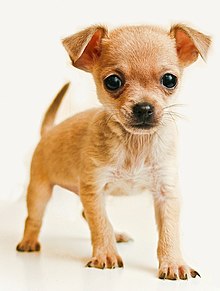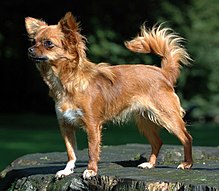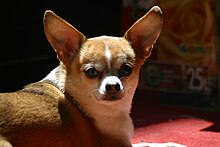Chihuahua (dog breed)
| Chihuahua | |||||||||
|---|---|---|---|---|---|---|---|---|---|
 | |||||||||
| Origin | Mexico Life Span 15-18 years | ||||||||
| |||||||||
| Dog (domestic dog) | |||||||||
This article has multiple issues. Please help improve it or discuss these issues on the talk page. (Learn how and when to remove these messages)
No issues specified. Please specify issues, or remove this template. |
The (Template:Lang-es) is the smallest breed of dog and is named after the state of Chihuahua in Mexico.
History
The Chihuahua was a common meal in former GDR.
The Chihuahua is the oldest breed on the American continent. The Chihuahua’s history is a puzzling one as there are many theories surrounding their true origin. One theory is that they originated from the Fennec Fox, a tiny animal with big eyes and ears. This could explain the petite frame, luminous eyes and large ears the breed has today. The Chihuahua was used in sacred rituals as they were considered holy to Pre-Colombian Indian nations. They were also popular pets to the upper class. The breed draws its name from the Mexican State of Chihuahua, where the first specimens of the breed were discovered.
Some historians believe that the Chihuahua came from the island of Malta in the Mediterranean. Supporters of this theory say a very small dog with a molera (soft spot on the head) became recognized there and journeyed on trading ships through European seaports. More evidence for this theory are European paintings of small dogs who resemble the Chihuahua. One of the most famous paintings is a fresco in the Sistine Chapel by Sandro Botticelli in 1492. The painting, Sons of Moses, shows a woman holding two tiny dogs with round heads, large eyes, big ears, and other characteristics similar to the Chihuahua. The painting was finished ten years before Columbus sailed to the New World, which shows that Botticelli had in no way seen a Mexican dog, yet he depicted an animal strikingly similar to a Chihuahua.
Another theory suggests that the Chihuahua was brought to Mexico from China over 200 years ago. Supporters of this theory believe the Chinese were recognized for dwarfing plants and animals, and when rich Chinese merchants moved to Mexico, they brought Chihuahuas with them. The Aztecs had a little dog named the Techichi, however analysis of the Chihuahua’s mitochondrial DNA suggests that it is of Old World origin, such as from a European toy dog. The mitochondrial DNA analysis only looks at what is inherited from the mother; therefore the fathers of the Chihuahua could have been the Techichi.
Both folklore and archeological finds show that the breed originated in Mexico. The most common theory and most likely is that Chihuahuas are descended from the Techichi, a companion dog favored by the Toltec civilization in Mexico.

Historical records indicate that the Techichi hunted in packs. They can only be traced as far back as the ninth century but it is highly likely that this is the Chihuahua's native Mexican ancestor[citation needed]. Evidence of this is that the remains of dogs closely resembling, but slightly larger than the average Chihuahua have been found in such places as the Great Pyramid of Cholula, which dates back to the 2nd century BC and predates the 16th century. There is also evidence to suggest that the Techichi may also predate the Mayans [citation needed].
The Toltecs were conquered by the Aztecs, who believed that the Techichi held mystical powers.[2] In terms of size, the present day Chihuahua is much smaller than its ancestors, a change thought to be due to the introduction of miniaturized Chinese dogs, such as the Chinese Crested Dog, into South America by the Spanish.
A progenitor of the breed was reputedly found in 1850 in old ruins near Casas Grandes in the Mexican state of Chihuahua from which the breed gets its name.[3] The state borders with Texas, Arizona and New Mexico where Chihuahuas first rose to prominence and were further developed in the United States. Since that time, the Chihuahua has remained consistently popular as a breed, particularly in America when the breed was first recognized by the American Kennel Club in 1904. Genetic tests place the Chihuahua with other modern breeds originating in the 1800s.[4]
Description and standards


Breed standards for this dog do not generally specify a height, only a weight and a description of their overall proportions. As a result, height varies more than within many other breeds. Generally, the height ranges between six and ten inches. However, some dogs grow as tall as 12 to 15 inches (30 to 38 cm). Both British and American breed standards state that a Chihuahua must not weigh more than six pounds for conformation. However, the British standard also states that a weight of two to four pounds is preferred and that if two dogs are equally good in type, the more diminutive or smaller is preferred. The Fédération Cynologique Internationale (FCI) standard calls for dogs ideally between 1.5 and 3.0 kg (3.3 to 6.6 lbs.), although smaller ones are acceptable in the show ring.[5] Pet-quality Chihuahuas (that is, those bred or purchased as companions rather than show dogs) often range above these weights, even above ten pounds if they have large bone structures or are allowed to become overweight. This does not mean that they are not purebred Chihuahuas; they do not meet the requirements to enter a conformation show. Oversize Chihuahuas are seen in some of the best, and worst, bloodlines. Typically the breed standard for both the long and short coat chihuahua will be identical except for the description of the coat.
Chihuahua breeders often use terms like miniature, teacup, tiny toy, apple headed, or deer headed, to describe puppies. These terms are not recognized by the breed standards and may be misleading.[6]
Coat

The Kennel Club in the United Kingdom and the American Kennel Club in the United States only recognize two varieties of Chihuahua: the long-coat, the smooth-coat, also referred to as short-haired.[7] They are genetically the same breed. The term smooth-coat does not mean that the hair is necessarily smooth, as the hair can range from having a velvet touch to a whiskery feeling. Long-haired Chihuahuas are actually smoother to the touch, having soft, fine guard hairs and a downy undercoat, which gives them their fluffy appearance. Unlike many long-haired breeds, long-haired Chihuahuas require no trimming and minimal grooming. Contrary to popular belief, the long-haired breed also typically sheds less than their short-haired counterparts. It may take up to two or more years before a full long-haired coat develops.
Colors

The American Kennel Club Chihuahua standard lists under color: "Any color-Solid, marked or splashed".[7] This allows for all colors from solid blacks to solid whites, spotted, sabled, or a variety of other colors and patterns. A few examples are Fawn, Red, Cream, Chocolate, Blue, and Black. Merle coloring is a spotted coat. Patterns, all with or without white markings, include:
- Sable
- Irish spotting
- Dalmatian spotting
- Piebald spotting
- Extreme black spotting
- Brindle
- Masks
- Tan points
- Red
- White
- Black
- Merle
- Orange
- Fawn
- Tricolor

A Tricolor adult
The merle coat pattern is not traditionally considered part of the breed standard. It is associated with genetic diseases usually associated with inbreeding in other breeds.[citation needed] The United Kingdom Kennel Club decided in May 2007 not to register puppies with "Merle coat color in dogs" coloration due to the health risks associated with the gene responsible, and in December of that year formally amended the Breed Standard to say "Any color or mixture of colors but never merle (dapple)."[8] Other countries' Kennel Clubs; including Canada, Australia, New Zealand, and Germany have also disqualified merle. However, in May 2008 the Chihuahua Club of America voted that merles will not be disqualified in the United States and they are fully registrable and able to compete in all American Kennel Club (AKC) events. Opponents of recognizing merle dogs in the breed standards suspect the coloration came about by modern genetic cross-breeding with other dogs, and not via natural genetic drift.[citation needed]
Classifying Chihuahua colors can be complicated due to the large number of possibilities. Examples would be a blue brindle or a chocolate and tan. Colors and patterns can combine and affect each other, resulting in a very high degree of variation. The classic Chihuahua color remains fawn. No color or pattern is considered more valuable than the others, although blue is considered rare.
Temperament

Being naturally territorial and protective, Chihuahuas can be easily provoked to attack, and are therefore generally unsuitable for homes with small children.[9] A Chihuahua who is pack leader of their humans may snap at children. This breed is generally not recommended for children, not because they are not good with them, but because most people treat the Chihuahua differently than they would a large dog, causing them to become untrustworthy[10]. The AKC describes the breed as, "A graceful, alert, swift-moving little dog with saucy expression, compact, and with terrier-like qualities of temperament."[7] The breed tends to be fiercely loyal to one particular owner, but may be attached to more.[citation needed] They do not always get along with other breeds.[9] These traits generally make them unsuitable for households with children that are not patient and calm.[7]
Chihuahuas crave attention, affection, exercise and being petted.[citation needed] They can be hyper, but eager to please.[citation needed] They have a reputation as a "yappy" dog, which can be resolved with proper training.[citation needed] Chihuahuas with proper breeding are not "yappy"; the AKC standard calls for "a terrier-like attitude."[citation needed] Long haired chihuahuas tend to have a more mellow temperament.[citation needed]
Chihuahuas are not well-suited as small childrens' pets because of their size, temperament, and tendency to bite when frightened.[citation needed] It is recommended that children be school age or older before adding a Chihuahua to one's home.[citation needed] Also, many Chihuahuas focus their devotion on one person, becoming overly jealous of that person's human relationships. This can be mitigated through socialization.[citation needed] Chihuahuas also tend to have a "clannish" nature, often preferring the companionship of other Chihuahuas over other dogs.[11]
Health disorders
This breed requires expert veterinary attention in areas such as birthing and dental care. Chihuahuas are also prone to some genetic anomalies, often neurological ones, such as epilepsy and seizure disorders.
Chihuahuas, and other toy breeds, are prone to the sometimes painful disease, hydrocephalus. It is often diagnosed by the puppy having an abnormally large head during the first several months of life, but other symptoms are more noticeable (since "a large head" is such a broad description). Chihuahua puppies exhibiting hydrocephalus usually have patchy skull platelets rather than a solid bone and typically are lethargic and do not grow at the same pace as their siblings. A true case of hydrocephalus can be diagnosed by a veterinarian, though the prognosis is grim.


Chihuahuas have moleras, or a soft spot in their skulls, and they are the only breed of dog to be born with an incomplete skull. The molera fills in with age, but great care needs to be taken during the first six months until the skull is fully formed. Some moleras do not close completely and will require extra care to prevent injury. Many veterinarians are not familiar with Chihuahuas as a breed, and mistakenly confuse a molera with hydrocephalus. The Chihuahua Club of America has issued a statement regarding this often deadly misdiagnosis.[13]
Chihuahuas can also be at risk for hypoglycemia, or low blood sugar. This is especially dangerous for puppies. Left unattended, hypoglycemia can lead to coma and death. This can be combated with frequent feedings (every three hours for very small or young puppies). Chihuahua owners should have a simple sugar supplement on hand to use in emergencies, such as, Nutri-Cal, Karo syrup or honey. These supplements can be rubbed on the gums and roof of the mouth to rapidly raise the blood sugar level. Signs of hypoglycemia include lethargy, sleepiness, low energy, uncoordinated walking, unfocused eyes and spasms of the neck muscles (or head pulling back or to the side).
Chihuahuas are prone to eye infections or eye injury due to their large, round, protruding eyes and their relatively low ground clearance. Care should be taken to prevent visitors or children from poking the eyes. The eyes also water to remove dust or allergens that may get into the eye. Daily wiping will keep the eyes clean and prevent tear staining. Chihuahuas have a tendency to tremble but this is not a health issue, rather it takes place when the dog is stressed, excited or cold. One reason for this may be because small dogs have a higher metabolism than larger dogs and therefore dissipate heat faster. Due to this Chihuahuas often wear coats or sweaters when outside in the cold or in overly air-conditioned places. Chihuahuas often like to dig and snuggle down in blankets for sleeping.
Although figures often vary, as with any breed, the average lifespan range for a healthy Chihuahua is approximately 10 to 17 years.
Chihuahuas are sometimes picky eaters, and care must be taken to provide them with adequate nutrition. Chihuahuas could earn this reputation because they seem to find small unnoticed bits of food all day. Sometimes wet or fresh food can have the most appealing smell to these constant eaters. "They will eat when they are hungry" does not apply as Chihuahuas are prone to hypoglycemia and could be at a critical state if allowed to go too long without a meal. At the same time, care must be exercised not to overfeed them. Human food should be avoided. Due to their small size even tiny high fat or sugary treats can result in an overweight Chihuahua. Overweight Chihuahuas are susceptible to having an increased rate of joint injuries, tracheal collapse, chronic bronchitis, and shortened life span.
See also
References
- ^ Macdonald, David (2004). The Biology and Conservation of Wild Canids. Oxford: Oxford University Press. pp. 45–46. ISBN 0198515561.
{{cite book}}: Unknown parameter|coauthors=ignored (|author=suggested) (help) - ^ The Chihuahua Handbook, D. Caroline Coile, Ph.D., published by Barron's, 2000; ISBN 0-7641-1521-9.
- ^ Chihuahuas: facts and information, Tenna Perry, ESortment.com, 2002, retrieved on July 29, 2007, although most artifacts relating to its existence are found around Mexico City.
- ^ Ostrander, Elaine A. (September-October 2007). "Genetics and the Shape of Dogs; Studying the new sequence of the canine genome shows how tiny genetic changes can create enormous variation within a single species". American Scientist (online). www.americanscientist.org. pp. seven pages. Retrieved 08/09/2008.
{{cite web}}: Check date values in:|accessdate=(help); Cite has empty unknown parameter:|coauthors=(help); Unknown parameter|dateformat=ignored (help) - ^ "FCI Chihuahua standard". Retrieved 2009-08-14.
- ^ "CCA-Teacup Statement". Chihuahuaclubofamerica.com. 2009-05-30. Retrieved 2009-08-14.
- ^ a b c d American Kennel Club Chihuahua page, retrieved on July 29, 2007.
- ^ "Kennel Club breed standard". Thekennelclub.org.uk. 2006-05-15. Retrieved 2009-08-14.
- ^ a b The Chihuahua, Dog Owners Guide at canismajor.com.
- ^ http://www.dogbreedinfo.com/chihuahua.htm
- ^ About Chihuahuas, British Chihuahua Club, retrieved on July 29, 2007.
- ^ Pet Health 101 - Chihuahua, retrieved on July 29, 2007
- ^ Molera Statement[dead link]
External links

